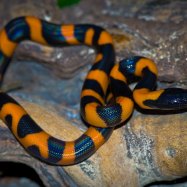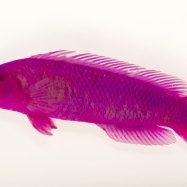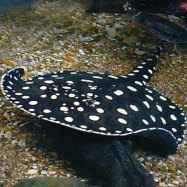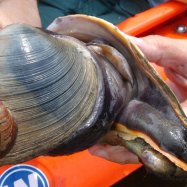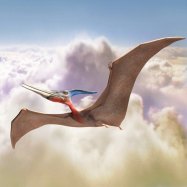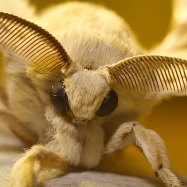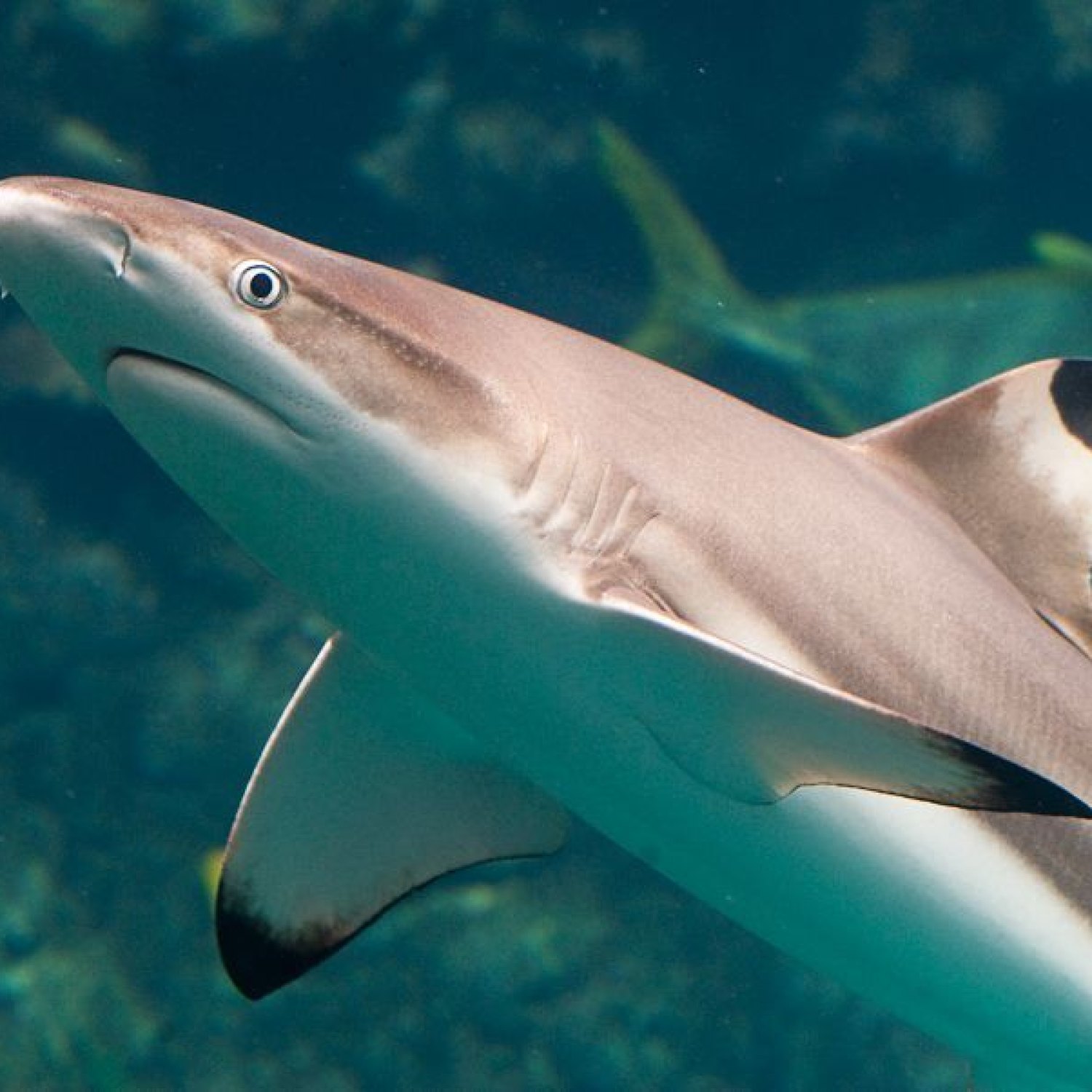
Blacktip Reef Shark
Up to 6 feet
The Blacktip Reef Shark, found in tropical and subtropical oceans, is a stunning creature with a sleek, slender body shape from the Carcharhinidae family. Growing up to 6 feet in length, it is a sight to behold in its natural habitat. #BlacktipReefShark #Carcharhinidae #oceanlife
Animal Details Summary:
Common Name: Blacktip Reef Shark
Kingdom: Animalia
Habitat: Coral reefs, coastal waters
The Mighty Predator of the Coral Reefs: Blacktip Reef Shark
Welcome to the depths of the ocean, where the mysterious creatures of the sea roam freely. Among the many intriguing species, one stands out for its unique adaptations and impressive hunting skills - the blacktip reef shark.Scientifically known as Carcharhinus melanopterus, the blacktip reef shark is a member of the animal kingdom, phylum Chordata, and class Chondrichthyes. It belongs to the order Carcharhiniformes and the family Carcharhinidae - the same family as the notorious great white shark Blacktip Reef Shark.
Primarily known by its common name, the blacktip reef shark is a fierce and agile predator found in coral reefs and coastal waters of the Indo-Pacific region. With its slim and streamlined body, this shark can grow up to 6 feet in length and weighs around 40 to 44 pounds.
If you're fascinated by the world of sharks and curious about the blacktip reef shark, let's dive deeper and discover more about these magnificent creatures.
Habitat and Geographical Distribution
The blacktip reef shark is a tropical species and is commonly found in the warm waters of the Indo-Pacific region. Its geographical distribution ranges from the Maldives, the Philippines, Indonesia, and Australia.While they prefer shallow coastal waters, blacktip reef sharks are also known to venture into the open ocean. However, they are primarily found in coral reefs, lagoons, and inshore waters, where they can easily hunt their prey.
The coral reefs, with their abundance of marine life, provide a perfect habitat for these sharks. Their streamlined body and strong muscles make them efficient swimmers, allowing them to navigate the complex coral structures with ease Bark Scorpion.
Appearance and Body Structure
As their name suggests, blacktip reef sharks have distinct black markings on the tips of their fins. Their body coloration ranges from grey-brown on the dorsal side to a contrasting white underbelly. This coloration serves as a natural camouflage, making it easier for them to blend in with the ocean's depths and hunt their prey.One of the notable physical features of the blacktip reef shark is its slender and streamlined body. This body shape, along with its powerful tail, allows the shark to swim with great speed and agility.
With a length of up to 6 feet, the blacktip reef shark may not be the largest shark species, but it is still an impressive sight in the ocean. This species has a pair of large, oval-shaped eyes with a well-developed sense of vision, enabling them to spot their prey from a distance.
Diet and Feeding Behavior
Being a carnivorous species, the blacktip reef shark feeds on a variety of prey, including small fishes, crustaceans, and cephalopods. Their sharp teeth and powerful jaws are well-suited for hunting, tearing, and consuming their prey efficiently.They are opportunistic hunters and use a combination of stealth and agility to catch their prey. With their streamlined body, they can quickly accelerate towards their target and take it by surprise. Blacktip reef sharks are also known to hunt in groups, especially during the spawning season of their primary food source, the mullet fish.
The blacktip reef shark's impressive hunting skills are not only limited to its prey but also to its ability to avoid larger predators. When confronted by larger sharks or other potential threats, blacktip reef sharks use their agility to escape unharmed.
Relationship to Humans
The blacktip reef shark is generally regarded as a shy and non-aggressive species towards humans. They are not known to attack unprovoked, and there have been very few documented cases of blacktip reef shark attacks on humans.In some areas, these sharks have been known to approach divers out of curiosity, but they usually keep a safe distance. However, it is essential to note that these are still wild animals and should always be respected and observed from a safe distance.
Despite their non-threatening nature towards humans, blacktip reef sharks are still at risk from human activities such as overfishing and habitat destruction. These factors have led to a decline in their population, making them vulnerable to extinction.
Conservation and Protection Efforts
To ensure the survival of the blacktip reef shark, conservation efforts have been put in place in some countries to protect their habitats and regulate fishing practices. For instance, in Australia, the blacktip reef shark is listed as a protected species under the Fisheries Management Act.Furthermore, organizations such as the International Union for Conservation of Nature (IUCN) have listed the blacktip reef shark as a near-threatened species, highlighting the need for more conservation efforts to protect them.
One of the most effective ways to ensure the survival of these magnificent creatures is through education and awareness. By understanding and appreciating their role in the ocean ecosystem, we can work towards their protection and conservation.
Conclusion
In conclusion, the blacktip reef shark is a fascinating and important species in the ocean. With their impressive adaptations and unique features, they play a crucial role in maintaining the balance of the coral reef ecosystem.As we continue exploring the depths of the ocean, let us not forget to appreciate and protect these incredible creatures of the sea. With proper conservation efforts and responsible human behavior, we can ensure that the blacktip reef shark continues to thrive in our oceans for generations to come.

Blacktip Reef Shark
Animal Details Blacktip Reef Shark - Scientific Name: Carcharhinus melanopterus
- Category: Animals B
- Scientific Name: Carcharhinus melanopterus
- Common Name: Blacktip Reef Shark
- Kingdom: Animalia
- Phylum: Chordata
- Class: Chondrichthyes
- Order: Carcharhiniformes
- Family: Carcharhinidae
- Habitat: Coral reefs, coastal waters
- Feeding Method: Carnivorous
- Geographical Distribution: Indo-Pacific region
- Country of Origin: Australia, Indonesia, Maldives, Philippines
- Location: Tropical and subtropical oceans
- Animal Coloration: Grey-brown with black-tipped fins, white underbelly
- Body Shape: Slender and streamlined
- Length: Up to 6 feet
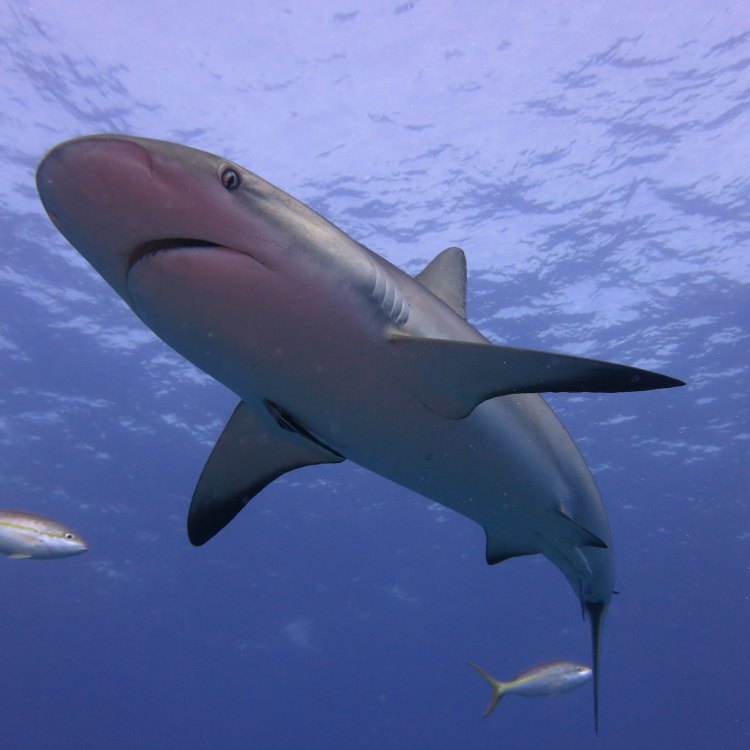
Blacktip Reef Shark
- Adult Size: 4-5 feet
- Average Lifespan: 20 years
- Reproduction: Viviparous
- Reproductive Behavior: Internal fertilization
- Sound or Call: None
- Migration Pattern: Seasonal migration
- Social Groups: Solitary or in small groups
- Behavior: Nocturnal, active predator
- Threats: Overfishing, habitat destruction
- Conservation Status: Near Threatened
- Impact on Ecosystem: Maintains balance in coral reef ecosystems
- Human Use: Fishing, ecotourism
- Distinctive Features: Black-tipped fins, streamlined body
- Interesting Facts: Known for their black-tipped fins and their habit of leaping out of the water
- Predator: Large sharks, dolphins
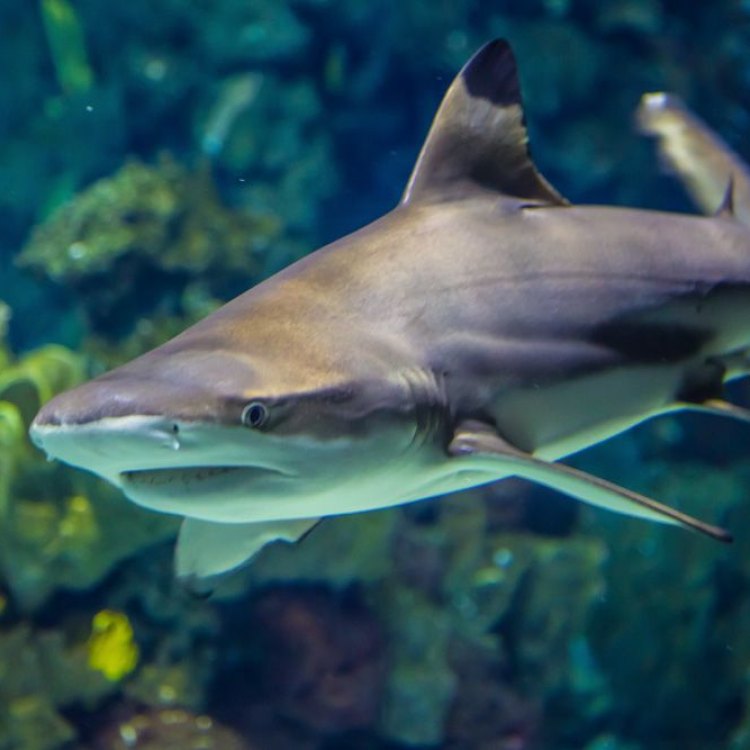
Carcharhinus melanopterus
Discover the Mysterious World of the Blacktip Reef Shark
The ocean is a vast and mysterious world, home to countless species that have fascinated humans for centuries. Among these creatures, one stands out with its distinctive black-tipped fins and unique behaviors - the blacktip reef shark.Often seen swimming gracefully in shallow waters near coral reefs, these sharks may seem docile and unassuming. However, they possess fascinating features and behaviors that make them an integral part of their ecosystem PeaceOfAnimals.Com. In this article, we will dive into the world of the blacktip reef shark and discover the secrets behind this enigmatic species.
A Not-So-Large, Yet Powerful Predator
The blacktip reef shark, or Carcharhinus melanopterus, is a relatively small species, with adults typically reaching lengths of 4-5 feet. However, do not let their size fool you. These sharks are known as active predators, constantly on the hunt for small fish, crustaceans, and octopuses that make up their diet.Their slender and streamlined bodies are perfectly adapted for quick and agile movements, making them efficient hunters. With their excellent sense of smell and sharp eyesight, they are well-equipped to navigate the complex underwater world and locate their next meal.
Interestingly, despite their intimidating appearance, blacktip reef sharks rarely pose a threat to humans. They are known to be shy and timid creatures, and their small size means they do not view humans as potential prey. In fact, blacktip reef sharks have a history of actively avoiding interactions with humans, making them a relatively safe species to swim alongside Beauty Rat Snake.
A Sheltered Life: Reproduction and Social Behavior
Reproduction plays a crucial role in the life of the blacktip reef shark. As with other shark species, they exhibit a reproductive behavior known as viviparity, where the embryos develop and are nourished inside the mother's body until they are ready to be born.The process of fertilization is also unique to these sharks. Unlike many fish species that fertilize their eggs externally, blacktip reef sharks practice internal fertilization, where males use their claspers to transfer sperm to the female's reproductive organs. This behavior allows for a higher chance of successful fertilization and ensures the survival of their offspring.
Once pregnant, female blacktip reef sharks will give birth to 2-4 pups after a gestation period of approximately 16 months. Interestingly, these sharks have the ability to reproduce without mating, a phenomenon called parthenogenesis. This behavior is rarer in sharks but allows for a population to survive even with a limited number of male sharks present.
Unlike other shark species that form large social groups, blacktip reef sharks are solitary creatures, preferring to live and hunt alone or in small groups. However, during the breeding season, they may gather in large aggregations near coral reefs, providing a spectacular sight for divers and snorkelers.
Under the Cover of Darkness: Nocturnal Behavior
One of the unique behaviors of blacktip reef sharks is their nocturnal activity. As the sun sets and the reef becomes shrouded in darkness, these sharks come alive, hunting and patrolling their territory.Scientists believe that this behavior is due to the availability of prey at night in shallow waters. Being efficient hunters, blacktip reef sharks have adapted their behavior to take advantage of this opportunity, making them important contributors to maintaining a healthy ecosystem.
However, their nocturnal behavior also serves as a defense mechanism against larger predators. With their dark-colored bodies blending into the blackness of the water, these sharks can escape the notice of larger predators, such as other shark species and dolphins, who are their primary predators.
On the Move: Migration Patterns
Another intriguing feature of the blacktip reef shark is its seasonal migration pattern. These sharks are known to regularly migrate to different locations as the seasons change, usually following a specific route.During the warmer months, blacktip reef sharks can be found in the shallow waters of the tropics, where they breed and give birth to their young. As the temperature drops, they migrate to deeper and more temperate waters, seeking warmer temperatures.
This cycle of movement serves a vital purpose in maintaining a diverse and balanced ecosystem. By moving to different areas, these sharks help to spread out their feeding pressure and give prey populations a chance to replenish, ensuring a sustainable food source for all species in the ecosystem.
The Threat of Human Activities and Conservation Efforts
Despite their important role in the ecosystem, blacktip reef sharks face numerous threats, primarily due to human activities. Overfishing, pollution, and habitat destruction are among the main factors impacting their population.Unregulated fishing practices, often targeting these sharks for their fins, have caused a significant decline in their numbers. This practice, known as shark finning, involves cutting off a shark's fins and discarding the rest of the body, causing immense suffering and death for the sharks.
Habitat destruction, primarily through coastal development and pollution, also poses a significant threat to the survival of blacktip reef sharks. These sharks rely on coral reefs for shelter and breeding, and the destruction of these essential habitats severely impacts their ability to survive and thrive.
Thankfully, conservation efforts have been put in place to protect these sharks and their habitats. Measures such as fishing regulations, marine protected areas, and sustainable tourism practices have been implemented to help decrease the impact of human activities on these sharks and promote their conservation.
The Role of Blacktip Reef Sharks in Ecosystem Balance
While often seen as intimidating predators, blacktip reef sharks play an essential role in maintaining balance in their ecosystem. As active predators, they help to regulate the population of smaller species, preventing overpopulation and maintaining a healthy prey population.Their movement patterns also play a crucial role in redistributing their feeding pressure, ensuring the survival of various species. Additionally, as bottom-dwellers, blacktip reef sharks help to keep the ocean floor clean by feeding on dead or dying organisms, maintaining a healthy and diverse ecosystem.
Without these sharks, the delicate balance of coral reef ecosystems can be greatly disrupted, leading to devastating consequences for the entire ecosystem.
Human Use: Fishing and Ecotourism
Apart from their ecological importance, blacktip reef sharks also have significance in human use. In some parts of the world, these sharks are fished for their meat, liver oil, and fins, providing a source of income for local communities.In recent years, there has also been an increase in ecotourism activities centered around blacktip reef sharks, allowing people to witness these magnificent creatures in their natural habitat responsibly. This type of tourism promotes awareness and conservation efforts, providing a more sustainable way for humans to interact with these sharks.
The Distinctive Features and Interesting Facts of Blacktip Reef Sharks
Blacktip reef sharks are easily recognizable by their distinctive black-tipped fins, which give them their name. However, these sharks possess other unique features that make them stand out among other species.Their slender and streamlined bodies allow them to dart and maneuver quickly through the water, giving them an advantage in pursuing their prey. Their dark-colored bodies also serve as camouflage against larger predators, making them less noticeable and increasing their chances of survival.
Apart from their appearance and behaviors, blacktip reef sharks are also known for their habit of leaping out of the water. This behavior, called breaching, is believed to serve several purposes, such as communication, feeding, or removing parasites, and is a fascinating sight to witness.
Discovering the Blacktip Reef Shark
In conclusion, the blacktip reef shark may be a relatively small and unassuming species, but they possess remarkable features and behaviors that make them an integral part of their ecosystem. From their unique reproductive behaviors to their role in maintaining ecosystem balance, these sharks continue to fascinate and intrigue researchers and individuals alike.As humans, it is important for us to recognize the significance of these creatures and take necessary steps to protect them from the threats they face. Only through our efforts can we ensure that future generations will be able to experience the wonder and beauty of the blacktip reef shark and the diverse ecosystem it inhabits.
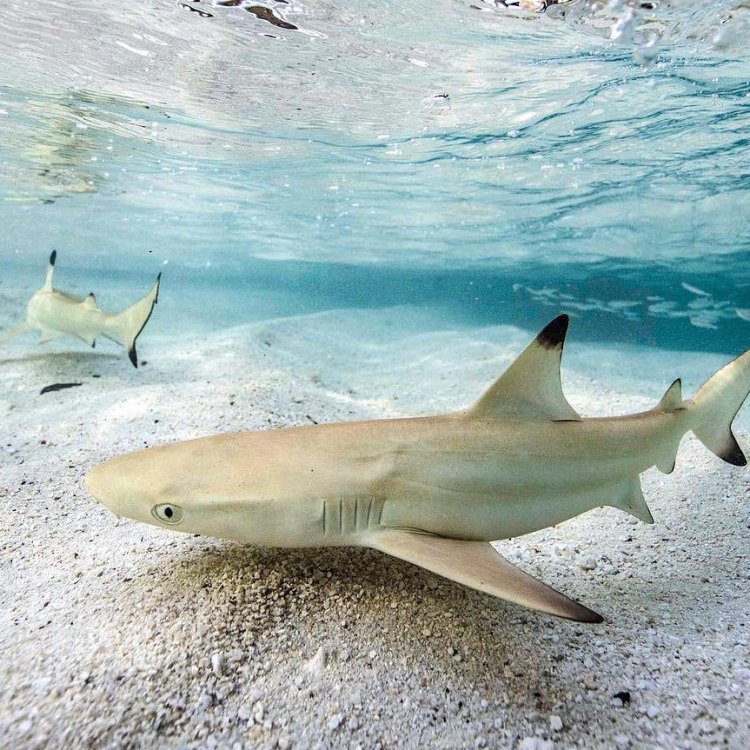
The Mighty Predator of the Coral Reefs: Blacktip Reef Shark
Disclaimer: The content provided is for informational purposes only. We cannot guarantee the accuracy of the information on this page 100%. All information provided here may change without prior notice.




